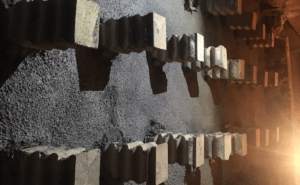Refractory Installation
Technology has continued to advance and in turn, refractory installation has become much more cost- and time-effective. Refractory lining alone has made the process for installers much easier, and that’s not to mention the reduced maintenance costs.
The lining acts as insulation to withstand extremely high temperatures, and also helps protect the structure from abrasion and thermal shock. Here’s a summary of the best ways to install monolithic refractory linings:
- Casting
- Ramming
- Shotcrete
- Gunite
1) Shotcrete
Shotcrete is typically a low-cement, low-moisture refractory that is fully tempered and mixed with water and special binding additives, and then projected at high velocity onto a surface. With shotcrete, the concrete is already mixed in a cement truck before you shoot it out of a hose,
2) Gunite
Gunite is a dry monolithic refractory designed for use with dry gunning equipment. It uses compressed air to send the dry material to the nozzle, where it mixes with water. Then it sprays out at super high velocity, which compacts the material on placement.
3) Ramming
Ramming plastics and castles is perfect for allowing workers to hand-ram them into place. Lining-support fittings are attached to the shell (metal anchors or ceramics tile anchors for the wall). The material is quite literally rammed into place using a pneumatic hand hammer. Forms may or may not be used, depending on the situation.
4) Casting
Casting refers to pouring wet castables into forms. Castables can be poured into forms to achieve whatever shape is desired or even molded by hand. Once the cement in the mix is hydrated and completely secure, the forms can be removed.
Choosing an Installation Method
Proper refractory installation is vital to achieving a quality refractory lining. Choosing the right installation method comes down to several factors, including:
- Site Conditions: Is the site at a high elevation? Will you be able to set up near the work site? Will you need to stop and start several times?
- Volume: Gunite and shotcrete methods deliver high volumes in a short amount of time (upwards of 5 tons per hour), so you must be prepared to handle that in your installation planning.
- Budget: Even when the price doesn’t vary much between materials, installation methods that lead to more waste will generally end up costing you more.
- Installation Team’s Skill Level: Whether shotcreting, guniting, ramming or casting, an inexperienced crew can directly affect the amount of refractory material waste, and therefore the total job cost.
- Bakeout: Different refractories have different bakeout times and these should be considered in your project schedule.
Summary
If you need more assistance determining which refractory installation method is best for you, feel free to reach out to us using our contact form. If you’re ready to move on with your project, fill out our free quote form and a Schad team member will reach out to you shortly!
